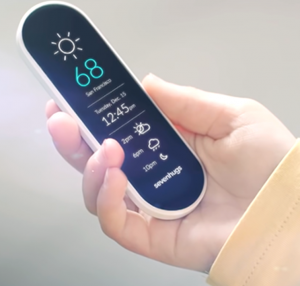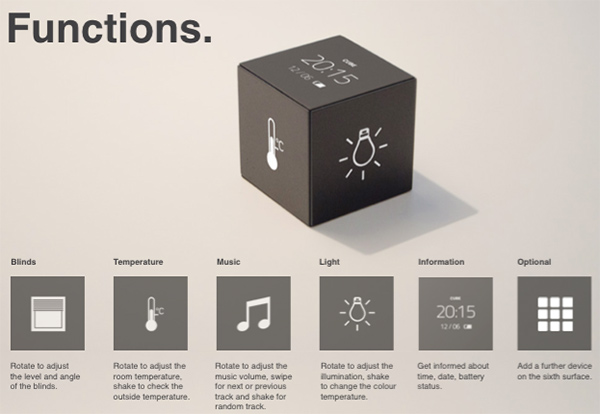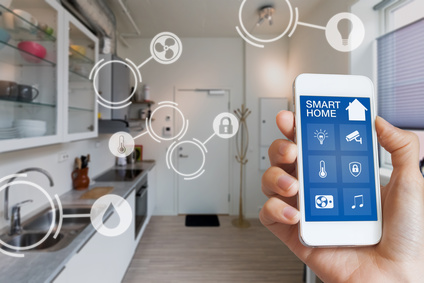Interaktions-Paradigmen (allgemein): Unterschied zwischen den Versionen
(→Exploring) |
|||
| (5 dazwischenliegende Versionen desselben Benutzers werden nicht angezeigt) | |||
| Zeile 3: | Zeile 3: | ||
Rogers et al. 2015. Interaction Design. WILEY. | Rogers et al. 2015. Interaction Design. WILEY. | ||
| − | + | In ihrem viel beachteten Buch zu Interaktionsdesign/User Experience Design beschreiben Rogers et al. vier Hauptweisen in welchen Menschen mit interaktiven Systemen interagieren: ''einen Befehl absetzen (Instructing)'', ''eine Konversation mit einem System führen (Conversing)'', ''Objekte manipulieren/verstellen (Manipulating)'' und ''Welten erkunden (Exploring)''. Es kann beim Designen eines interaktiven Systems -- wie etwa einem Smart Home -- nützlich sein, diese vier Arten mit einem System zu interagieren im Hinterkopf zu behalten. | |
=Instructing= | =Instructing= | ||
"...where users issue instructions to a system. This can be done in a number of ways, including: typing in commands, selecting options from menus in a windows environment or on a multitouch options from menus in a windows environment or on a multitouch screen, speaking aloud commands, gesturing, pressing buttons, or using a combination of function keys." (Rogers et al. 2015. Interaction Design) | "...where users issue instructions to a system. This can be done in a number of ways, including: typing in commands, selecting options from menus in a windows environment or on a multitouch options from menus in a windows environment or on a multitouch screen, speaking aloud commands, gesturing, pressing buttons, or using a combination of function keys." (Rogers et al. 2015. Interaction Design) | ||
| + | |||
| + | [[image:smarthomeremote.png|300px]] | ||
| + | |||
| + | Ein Befehl (eine Instruktion) wird mit einer Smart Home Fernbedienung abgesetzt [https://www.housecontrollers.de/smart-home/smart-home-fernbedienungen-uebersicht/ Quelle; Zugriff 19. Januar 2021] | ||
=Conversing= | =Conversing= | ||
“...where users have a dialog with a system. Users can speak via an interface or type in questions to which the system replies via text or speech output”. (Rogers et al. 2015. Interaction Design) | “...where users have a dialog with a system. Users can speak via an interface or type in questions to which the system replies via text or speech output”. (Rogers et al. 2015. Interaction Design) | ||
| + | |||
| + | [[image:conversation_siri.jpg|400px]] | ||
| + | |||
| + | Ein Dialog (Konversation) geführt mit Siri [https://www.dailymail.co.uk/sciencetech/article-3628362/Are-smart-personal-assistants-doomed-Researchers-say-people-embarrassed-talk-machine-especially-public.html Quelle; Zugriff 19. Januar 2021] | ||
=Manipulating= | =Manipulating= | ||
"... where users interact with objects in a virtual or physical space by manipulating them (e.g. opening, holding, closing, placing). Users can hone their familiar knowledge of how to interact with objects." (Rogers et al. 2015. Interaction Design) | "... where users interact with objects in a virtual or physical space by manipulating them (e.g. opening, holding, closing, placing). Users can hone their familiar knowledge of how to interact with objects." (Rogers et al. 2015. Interaction Design) | ||
| + | |||
| + | [[image:cubesmarthome.jpg]] | ||
| + | |||
| + | ''Cuebe'' ermöglicht Interaktion mit dem Smart Home durch Manipulation eines Würfels [https://atmelcorporation.wordpress.com/2015/06/09/cube-is-an-intuitive-tangible-interface-for-the-smart-home/ Quelle; Zugriff 19. Januar 2021] | ||
=Exploring= | =Exploring= | ||
"... where users move through a virtual environment or a physical space. Virtual environments include 3D worlds, and augmented and virtual reality systems. They enable users to hone their familiar knowledge of physically moving around. Physical spaces that use sensor-based technologies include smart rooms and ambient environments, also enabling people to capitalize on familiarity." (Rogers et al. 2015. Interaction Design) | "... where users move through a virtual environment or a physical space. Virtual environments include 3D worlds, and augmented and virtual reality systems. They enable users to hone their familiar knowledge of physically moving around. Physical spaces that use sensor-based technologies include smart rooms and ambient environments, also enabling people to capitalize on familiarity." (Rogers et al. 2015. Interaction Design) | ||
| + | |||
| + | [[image:vrsmarthome.jpg]] | ||
| + | |||
| + | Eine ''Augmented Reality'' App -- z.B. unter Einsatz einer ''VR Brille'' -- legt einen virtuellen Layer von Informationen über das Smart Home und erlaubt es durch Bewegung im Haus, die Funktionalitäten zu ''explorieren'' [http://www.limberg.at/smart-home-und-virtual-reality-das-wohnen-der-zukunft/ Quelle; Zugriff 19 Januar 2021] | ||
Aktuelle Version vom 19. Januar 2021, 10:51 Uhr
Rogers et al. 2015. Interaction Design. WILEY.
In ihrem viel beachteten Buch zu Interaktionsdesign/User Experience Design beschreiben Rogers et al. vier Hauptweisen in welchen Menschen mit interaktiven Systemen interagieren: einen Befehl absetzen (Instructing), eine Konversation mit einem System führen (Conversing), Objekte manipulieren/verstellen (Manipulating) und Welten erkunden (Exploring). Es kann beim Designen eines interaktiven Systems -- wie etwa einem Smart Home -- nützlich sein, diese vier Arten mit einem System zu interagieren im Hinterkopf zu behalten.
Inhaltsverzeichnis
Instructing
"...where users issue instructions to a system. This can be done in a number of ways, including: typing in commands, selecting options from menus in a windows environment or on a multitouch options from menus in a windows environment or on a multitouch screen, speaking aloud commands, gesturing, pressing buttons, or using a combination of function keys." (Rogers et al. 2015. Interaction Design)
Ein Befehl (eine Instruktion) wird mit einer Smart Home Fernbedienung abgesetzt Quelle; Zugriff 19. Januar 2021
Conversing
“...where users have a dialog with a system. Users can speak via an interface or type in questions to which the system replies via text or speech output”. (Rogers et al. 2015. Interaction Design)
Ein Dialog (Konversation) geführt mit Siri Quelle; Zugriff 19. Januar 2021
Manipulating
"... where users interact with objects in a virtual or physical space by manipulating them (e.g. opening, holding, closing, placing). Users can hone their familiar knowledge of how to interact with objects." (Rogers et al. 2015. Interaction Design)
Cuebe ermöglicht Interaktion mit dem Smart Home durch Manipulation eines Würfels Quelle; Zugriff 19. Januar 2021
Exploring
"... where users move through a virtual environment or a physical space. Virtual environments include 3D worlds, and augmented and virtual reality systems. They enable users to hone their familiar knowledge of physically moving around. Physical spaces that use sensor-based technologies include smart rooms and ambient environments, also enabling people to capitalize on familiarity." (Rogers et al. 2015. Interaction Design)
Eine Augmented Reality App -- z.B. unter Einsatz einer VR Brille -- legt einen virtuellen Layer von Informationen über das Smart Home und erlaubt es durch Bewegung im Haus, die Funktionalitäten zu explorieren Quelle; Zugriff 19 Januar 2021




